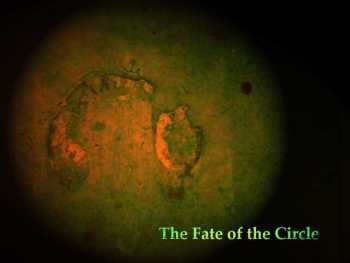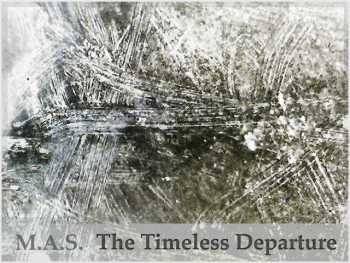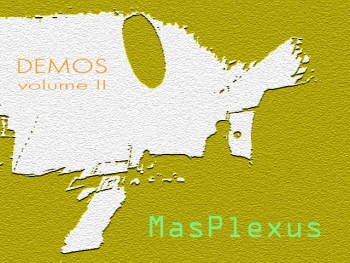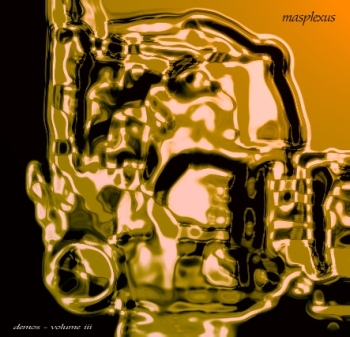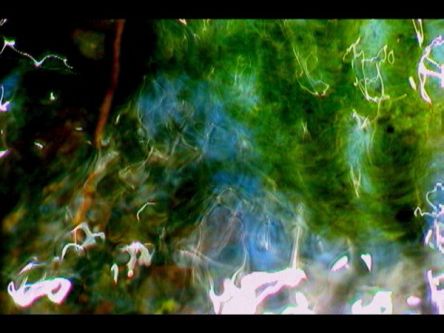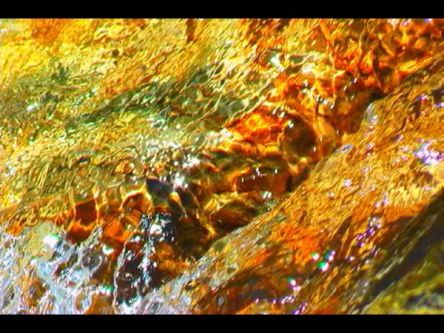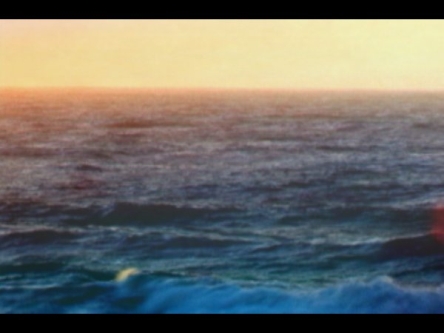After bidding his final farewell to all his friends and family, the Ever-Receding Man withdrew to a spot by the sea. There, he built a home out of jagged rock and put together a sparse set of furniture out of wood. He planted trees for all the fruits and vegetables he would need to sustain him; the trickling spring nearby promised to be an endless source of water for him and his plants to drink. And once the practical and mundane aspects of life were taken care of and he was comfortably settled in, he began to gradually turn blind.
On the day that marked the very end of his eyesight - it had finally reached the point that not even the slightest blur of light could be discerned during the highest noon - he planted an acorn seed directly in front of the main entrance to his house, as he had long since planned to do on this momentous occasion.
Now that he was no longer aware of the coming of day or of night, Time seemed practically disabled save for the rhythmic sound of the waves of the sea crashing onto the shore. The acorn seed eventually grew into a magnificent oak that dwarfed the rest of its surroundings. Although he could not see it, somewhere in his perpetual nighttime he was aware of every inch of growth that the tree enjoyed. He could almost feel the water rising up its trunk to nurture its many leaves.
The modest home he had constructed while his eyes still possessed their vision had a design which he intuited one day while watching a skylark soar up into the sky. It consisted of many small rooms, all roofless save for the bedroom which stood in the center. The walls extended straight outwards, North and South, and then curved around the house to serve as the surrounding fence, the main entrance faced West.
Protruding from one corner of the fence was a statue that he had meticulously sculpted out of the same jagged rock that made up the walls. It was of a man with wings holding a staff of golden brass whose upper tip was in the shape of a large circle, roughly one foot wide. He had found this staff in a yard sale while in his early teens, held on to it and cherished it for its sheer simplicity.
One night he had a dream of himself sleeping in his bedroom, which was now circular in shape and was missing its ceiling. From the shining moon above hung a curtain of subtle, silver radiance, which draped around his bed and shifted about ever so gently. Near the foot of the bed, a miniature version of the oak tree grew out of the mattress. Its branches extended and curled about, exploring the space around it thirstily. Finally, one of the branches penetrated through the moon's curtain and out the other side. He woke up with a start.
What must have been months later, he started to discern tiny dots of light in his vision. Was this his inner eye finally gaining the prominence to replace his lost eyesight? No, his vision was definitely returning and it became clearer over time. He was soon to realize that these dots were the stars in the sky, only they were unusually bright as if he were standing on top of a high mountain on a clear day.
Not all things became visible, however. He could see the vague blueness of the sea, but not the water, the dark earth beneath the grass in his fenced yard; he could see the sun, but not the moon - how he longed for the moon - and the occasional clouds and fog provided a discernible fuzz against an absent sky.
His newly gained eyesight did not seem to add any practical advantage to his life. Or so it seemed...It did not take long before he realized he could see, albeit vaguely, the shifting tides of the sea in the evenings, by watching the dancing movement of the stars reflected upon the surface of the invisible water softly crashing upon the shore.
Somewhat revelatory was the realization that this was the only visible source of regular movement available to him. Every evening, when the sky was clear enough, he would sit out before the sea and watch the invisible tides. He danced inwardly to their movement and, over time, he externalized the dance to the subtle and slow shifting of his own body. At times, a single "step" took hours to perform - in no apparent way did his movement seem synchronized with that of the sea of stars - other maneuvers were more swift and direct in their expression.
One night, he found his dance to feel especially natural. He felt that his body carried no weight and that it had taken on a life of its own. As he was losing himself more and more to the swaying movement he suddenly realized that his feet no longer touched the ground. He could discern the outline of the water's blue receding and now watched the vague shore from a bird's eye view. The glittering stars remained by his side, however.
Saturday, July 26, 2008
Wednesday, July 16, 2008
Transformative Music - Earning Serenity
As I've written in the past, any analysis of music from a psychological perspective should be taken with a grain of salt, at least in my opinion. When I do write about music, it is ultimately to communicate psychological insights, more than to illuminate new perspectives on music. I never compose music while thinking about the psychological processes at work, and yet my songs and their arrangements naturally end up portraying inherent patterns of psychological movement from which one can attain insight into the way consciousness moves over time.
Much of my music naturally progresses towards a place of meditative peace and simplicity, the Abstract, but such a domain must be earned. It is a destination that is difficult to reach. I am not speaking of one's usual state of calm and contentment, but that deeper state of serenity that can be attributed to higher states of mind.
Music works on consciousness through psychological resonance. If one does not jive with the music, one is effectively refusing to actualize the potential journey which the music offers.
There are two factors that determine resonance. The first can be called "psychological proximity". It is easier to attain a state of bliss if one is already in a state of joy, as opposed to in a state of anger or frustration. Similarly, if one hears music that is playful and light while one feels heavy and morose, the music is less likely to resonate with the listener.
The second factor can be called "inventory of experience". If one is currently in a state that is heavy and morose but is usually playful and lighthearted, then light and playful music is more likely to quickly snap one out of the heavy mood. This is an over simplification, of course. Typically, my songs try to evoke moods that are very unique in character and therefore most people do not find an entry point with which they can identify.
With respect to attaining a deep sense of serenity, if one has just gotten off from work, for example, after a hectic day dealing with aggressive clients and upper management, then soft, simple, abstract music is typically not going to resonate with the listener; in some ways the sense of calm that could be attained can be termed hypocritical, or repressive of the underlying tension that has not been resolved or shaken out from its roots. There must first be an entry point that makes the listener jive with the music and from there one is led to gradually travel towards the realm of inner peace, by going through the rounds that unfold or unweave the knots which have developed.
Even if one doesn't live a busy and fast-paced life, one's conscious mind typically does its best to clutter itself with all kinds of thoughts, desires, and concerns. That's what meditation is for, to empty oneself out, but the proper music can work as a natural aid.
The path of psychological travel from point A to point B is rarely, if ever, a straight line. The path to a meditative serenity can be especially complicated. One typically experiences much oscillation through various moods and perspectives before a higher, more restful state of mind is reached, and to trace the path one took involves awareness of at times highly subtle internal processes at work.
"Equinox" is a collection of my songs that serves as a sonic essay or a musical portrayal of the wide array of psychological movement one experiences before being released into a sea of calm. The progression towards the inevitable serenity is a natural one, which cannot be explained in words but should be experienced directly through the music.
Click here to listen to "Equinox".
If the reader would rather just sample "Equinox" to get a feel of what I'm talking about, the following song represents the turning point between the turbulence and the calm. It is a rather extreme example of what I've been talking about, because it begins in a rather aggressive and dark manner. But, this only serves to illuminate one out of many natural psychological progressions from a state of turmoil to a state of inner peace. It can be argued that perhaps the greatest purpose of music is to sublimate the lower states of mind into higher ones.
Another aspect of reaching a calm, meditative state through music is that the entry point used, that with which the listener can resonate, should nevertheless invite the intellect to a quietude. The intellect is typically, and naturally, on overdrive. Music that is catchy serves to keep the intellect going. A meditative calm is thus difficult to attain.
While "The Reversal" begins busy and interesting, and emotional, it is deliberately un-catchy and thus the initial busy-ness does not "bind" the listener's intellect. Secondly, the complicated sound textures that directly precede the period of calm can serve to massage one's intellect to a quietude by being overly complex to follow consciously, just as water trickling through a stream in "hyper-"stereo is also calming to the nerves because there are so many drops of water emerging from many places all at once.
In Equinox, "The Reversal" then leads to songs that are more abstract in nature, having finally arrived at a place of serenity.
Sunday, July 6, 2008
Precision and Ambiguity - Excerpt from "Tales of Crimson and the Child of Thea"
Crimson stole through the streets before the break of dawn. He climbed the staircase of an abandoned building to the roof on the 21st floor. There, he perched himself cross-legged on the edge and peered out onto the city.
He watched the day break into light, watched the sun slowly float above and beyond and into the Great Sea of the West, that strange mystery to which he knew he would one day belong.
As the night settled upon the city, he gazed at its shimmering lights in the distance. A breeze lapped upon his face from time to time. He closed his eyes and waited for the breeze to hit his face at the specific angle of 39 degrees from top left. When it finally did, he uttered the following words into the nighttime: "I represent the dissonance of a solar wind."
Sparks flew in a power plant nearby and ignited a fire that resulted in an electricity outage throughout various contours of the city. Crimson wandered through the darkened streets and withdrew into the shadow of an alley. He stood motionless against the wall, having first measured exactly 42 feet from the main street.
The Child of Thea had a dream in which a winged statue emerged out of the soil of a mathematician's backyard, despite having planted an acorn seed.
Crimson emerged out of the darkness floating two feet above the ground. His velocity quickened as he transformed into a cocoon of light. Almost instantly, he was reduced in size to a tiny incandescent iota that shot through the wilderness of the urban jungle.
Subscribe to:
Posts (Atom)











